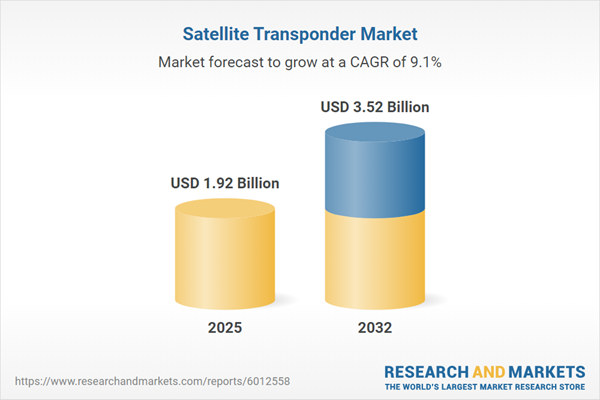Speak directly to the analyst to clarify any post sales queries you may have.
The satellite transponder market is undergoing significant transformation, driven by new technological advancements, evolving regulatory environments, and shifting demands from enterprise and government sectors. Strategic adaptation across operations and technology has become vital for sustaining competitive positioning in this space.
Market Snapshot: Satellite Transponder Market Size and Growth
In 2024, the satellite transponder market achieved a valuation of USD 1.76 billion with expectations to reach USD 1.92 billion by 2025, establishing a compound annual growth rate of 9.06%. This trajectory is being shaped by rising global broadband connectivity needs, expanded integrations with IoT ecosystems, and heightened activity in defense and government communications. Advances in digital payload technology, adaptive beamforming, and software-defined architectures are continuously enhancing network performance, cost efficiency, and service flexibility. Furthermore, market participants are leveraging digitized supply chains and robust partnership models to strengthen their agility and improve global service reliability within this fast-evolving environment.
Scope & Segmentation in the Satellite Transponder Market
This comprehensive analysis provides relevant segmentation and strategic direction tailor-made for senior executives seeking to upscale their influence and returns within the satellite transponder sector. The segmentation reveals how evolving technologies and deployment models are affecting value creation and operational efficiency globally.
- Orbit Type: Choices among Geostationary, Low Earth, and Medium Earth orbit configurations allow organizations to optimize coverage, latency, and application suitability, aligning satellite network design with customer requirements and regional expansion strategies.
- Transponder Type: Fixed transponders enable stable, long-term connectivity while Flexible transponders offer scalable capacity for clients that require rapid adjustment in response to usage fluctuations.
- Frequency Band: C-Band, Ka-Band, Ku-Band, and X-Band address diverse needs in broadcasting, government operations, and enterprise services, each shaped by specific regulatory and transmission parameters.
- Application: Broadband connectivity, Broadcast media delivery, Government and Military communication, Telecommunications backhaul, and VSAT networks all rely on satellite transponders to secure mission-critical links across both remote and urban environments.
- Regions: The Americas, Europe, Middle East & Africa, and Asia-Pacific each hold distinct regulatory structures, developmental trajectories, and market drivers, requiring localized go-to-market and operational strategies.
- Leading Providers: Organizations such as Intelsat S.A., SES S.A., Eutelsat S.A., Telesat Canada, China Satellite Communications Corporation, RSCC, Arabsat, Hispasat S.A., Inmarsat Global Limited, and Spacecom Israeli Satellite Communications Ltd. deliver a breadth of solutions targeted at commercial and government clients across different orbits and frequency bands.
Key Takeaways: Strategic Insights for Decision-Makers
- Ongoing adoption of flexible service portfolios and rapid scalability is broadening how operators can effectively address emerging market demands and diversify their service frameworks with multi-orbit and software-defined payload offerings.
- Effective collaboration between satellite hardware vendors, systems integrators, and terrestrial telecommunication partners is now fundamental to regulatory alignment and maintenance of resilient, transborder communications infrastructures.
- Integrating legacy network elements with next-generation deployments enables enterprises to maintain operational continuity while keeping pace with dynamic compliance requirements in increasingly complex environments.
- Technological advances such as adaptive beamforming and digital channelization are supporting more precise bandwidth management, allowing service providers to customize connectivity for specialized markets, including maritime and government applications.
- Procurement practices are evolving, emphasizing agility and transparency so organizations can better accommodate fast-changing market dynamics and meet unique or shifting customer expectations.
Tariff Impact on Supply Chain and Cost Structure
Forthcoming U.S. tariff adjustments for 2025 are forecasted to elevate component costs and influence supply chain timelines throughout the satellite transponder ecosystem. To manage these pressures, organizations are enhancing supplier diversification, adopting localized manufacturing capabilities, and redesigning hardware to reinforce overall resilience. Collaborative efforts between public authorities and the private sector further ensure steadier access to critical resources under changing trade policy landscapes.
Methodology & Data Sources
This report is founded on insights collected from experienced technology and operations professionals who specialize in satellite transponder integration. Conclusions have been substantiated by current regulatory expertise and peer-reviewed by subject matter authorities to provide clear and practical guidance to executive decision-makers.
Why This Report Matters
- Facilitates informed capital deployment, risk mitigation, and supplier strategy as global regulatory and technical conditions evolve.
- Supports procurement and business growth planning by identifying emergent trends and unique localization needs in satellite connectivity operations.
- Equips executive teams with credible, independent market intelligence, enabling confident and opportunity-driven actions throughout the satellite transponder value chain.
Conclusion
These insights equip executive leadership to confidently navigate ongoing transformation in the satellite transponder sector, capitalize on new technological directions, and ensure long-term organizational adaptability in a complex regulatory landscape.
Additional Product Information:
- Purchase of this report includes 1 year online access with quarterly updates.
- This report can be updated on request. Please contact our Customer Experience team using the Ask a Question widget on our website.
Table of Contents
3. Executive Summary
4. Market Overview
7. Cumulative Impact of Artificial Intelligence 2025
Companies Mentioned
The companies profiled in this Satellite Transponder market report include:- Intelsat S.A.
- SES S.A.
- Eutelsat S.A.
- Telesat Canada
- China Satellite Communications Corporation
- Russian Satellite Communications Company (RSCC)
- Arab Satellite Communications Organization (Arabsat)
- Hispasat S.A.
- Inmarsat Global Limited
- Spacecom Israeli Satellite Communications Ltd
Table Information
| Report Attribute | Details |
|---|---|
| No. of Pages | 181 |
| Published | October 2025 |
| Forecast Period | 2025 - 2032 |
| Estimated Market Value ( USD | $ 1.92 Billion |
| Forecasted Market Value ( USD | $ 3.52 Billion |
| Compound Annual Growth Rate | 9.0% |
| Regions Covered | Global |
| No. of Companies Mentioned | 11 |









